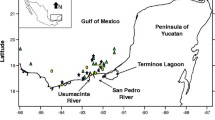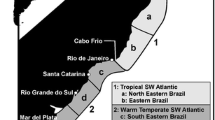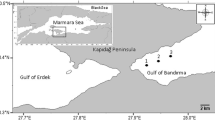Abstract
We aimed to compare the percentage of explained variance given by the relationship of species and functional groups of metazoan parasites of the dusky flounder Syacium papillosum and environmental variables from water and sediments in the Yucatan shelf (YS). Parasite data were obtained from 127 S. papillosum specimens collected from 17 of 67 stations. At each station, 46 environmental variables were measured, including hydrocarbons, heavy metals, and physicochemical variables from water and sediments. Fifteen functional groups were defined based on biological characteristics of 48 parasite species. Our multivariate statistical analyses showed that species and functional groups produced similar explained variance values (47.3% and 50% respectively). However, using functional groups the time and financial resources were minimal compared with those used for morphological and molecular identification to produce the species composition matrix. Thus, functional groups are the best choice from the point of view of saving time and money.
Similar content being viewed by others
References
Anderson M, Gorley RN, Clarke KR (2008) PERMANOVA + for PRIMER: guide to software and statistical methods. PRIMER-E Ltd, Plymouth
Beauchard O, Veríssimo H, Queirós AM, Herman PMJ (2017) The use of multiple biological traits in marine community ecology and its potential in ecological indicator development. Ecol Indic 76:81–96. https://doi.org/10.1016/j.ecolind.2017.01.011
Camargo JA, Alonso A, Salamanca A (2005) Nitrate toxicity to aquatic animals: a review with new data for freshwater invertebrates. Chemosphere 58:1255–1267
Chevenet F, Dolédec S, Chessel D (1994) A fuzzy coding approach for the analysis of long-term ecological data. Freshw Biol 31:295–309
Clarke K, Gorley R (2015) PRIMER v7: user manual/tutorial. PRIMER-E, Plymouth
Forbes VE, Palmqvist A, Bach L (2006) The use and misuse of biomarkers in ecotoxicology. Environ Toxicol Chem 25:272–280. https://doi.org/10.1897/05-257R.1
Huspeni TC, Lafferty KD (2004) Using larval trematodes that parasitize snails to evaluate a salt-marsh restoration project. Ecol Appl 14:795–804
Jensen K, Bullard SA (2010) Characterization of a diversity of tetraphyllidean and rhinebothriidean cestode larval types, with comments on host associations and life-cycles. Int J Parasitol 40:889–910
Llopis-Belenguer C, Balbuena JA, Lange K, de Bello F, Blasco-Costa I (2019) Towards a unified functional trait framework for parasites. Trends Parasitol 35:972–982. https://doi.org/10.1016/j.pt.2019.09.003
Mouillot D, Šimková A, Morand S, Poulin R (2005) Parasite species coexistence and limiting similarity: a multiscale look at phylogenetic, functional and reproductive distances. Oecologia 146:269–278. https://doi.org/10.1007/s00442-005-0194-1
Nachev M, Sures B (2016) Environmental parasitology: parasites as accumulation bioindicators in the marine environment. J Sea Res 113:45–50. https://doi.org/10.1016/j.seares.2015.06.005
Oug E, Fleddum AL, Rygg B, Frode O (2012) Biological traits analyses in the study of pollution gradients and ecological functioning of marine soft bottom species assemblages in a fjord ecosystem. J Exp Mar Biol Ecol 432–433:94–105. https://doi.org/10.1016/j.jembe.2012.07.019
Pérez-del Olmo A, Raga JA, Kostadinova A, Fernández M (2007) Parasite communities in Boops boops (L.) (Sparidae) after the prestige oil-spill: detectable alterations. Mar Pollut Bull 54:266–276
Poff NLR, Olden JD, Vieira NKM, Finn DS, Simmons MP, Kondratieff BC (2006) Functional trait niches of North American lotic insects: traits-based ecological applications in light of phylogenetic relationships. J N Am Benthol Soc 25:730–755
Reyes-Mendoza O, Mariño-Tapia IJ, Herrera-Silveira JA, Ruiz-Martínez G, Enríquez C, Largier J (2016) The effects of wind on upwelling off Cabo Catoche. J Coastal Res 32:638–650
Sures B, Nachev M, Selbach C, Marcogliese DJ (2017) Parasite responses to pollution: what we know and where we go in ‘Environmental Parasitology’. Parasit. Vectors 10, 65. http://doi.org/10.1186/s13071-017-2001-3
Vanderkooy SJ (ed) (2000) The flounder fishery of the Gulf of Mexico, United States: a regional management plan. Gulf States Marine fisheries Commission (Report no. 83). https://www.gsmfc.org/publications/GSMFC%20Number%20083.pdf. Accessed 7 May 2020
Vidal-Martínez VM, Centeno-Chalé OA, Torres-Irineo E, Sánchez-Ávila J, Gold-Bouchot G, Aguirre-Macedo ML (2014) The metazoan parasite communities of the shoal flounder (Syacium gunteri) as bioindicators of chemical contamination in the southern Gulf of Mexico. Parasit Vectors 7:541
Vidal-Martínez VM, Velázquez-Abunader I, Centeno-Chalé OA, May-Tec AL, Soler-Jiménez LC, Pech D, Mariño-Tapia I, Enriquez C, Zapata-Pérez O, Herrera-Silveira J, Hernández-Mena DI, Herzka SZ, Ordoñez-López U, Aguirre-Macedo M (2019) Metazoan parasite infracommunities of the dusky flounder (Syacium papillosum) as bioindicators of environmental conditions in the continental shelf of the Yucatan Peninsula, Mexico. Parasit Vectors 12:277. https://doi.org/10.1186/s13071-019-3524-6
Warburton EM, van der Mescht L, Stanko M, Vinarski MV, Korallo-Vinarskaya NP, Khokhlova IS, Krasnov BR (2017) Beta-diversity of ectoparasites at two spatial scales: nested hierarchy, geography and habitat type. Oecologia 184:507–520. https://doi.org/10.1007/s00442-017-3876-6
Whittaker RH (1972) Evolution and measurement of species diversity. Taxon 12:213–251
Acknowledgments
This research was financially supported by the – Mexican Ministry of Energy through the – Hydrocarbon Found, Project 201441. This is a contribution of the Gulf of Mexico Research Consortium (CIGoM). We acknowledge PEMEX´S specific request to the Hydrocarbon Found to address the environmental effects of oil spills in the Gulf of Mexico. The authors thank Francisco Puc Itzá, Clara Vivas, Gregory Arjona, Daniel Aguirre, Arturo Centeno, Efraín Sarabia, Nadia Herrera and Mirella Hernández de Santillana.
Author information
Authors and Affiliations
Corresponding author
Ethics declarations
Conflict of interest
The authors report no potential conflicts of interest.
Additional information
Publisher’s note
Springer Nature remains neutral with regard to jurisdictional claims in published maps and institutional affiliations.
Electronic supplementary material
Below is the link to the electronic supplementary material.
Rights and permissions
About this article
Cite this article
Vidal-Martínez, V.M., Ocaña, F.A., Soler-Jiménez, L.C. et al. Functional Groups of Metazoan Parasites of the Dusky Flounder (Syacium papillosum) as Bioindicators of Environmental Health of the Yucatan Shelf. Bull Environ Contam Toxicol 108, 24–29 (2022). https://doi.org/10.1007/s00128-021-03177-9
Received:
Accepted:
Published:
Issue Date:
DOI: https://doi.org/10.1007/s00128-021-03177-9




